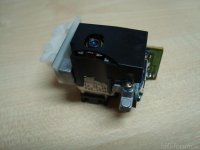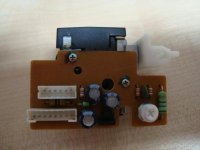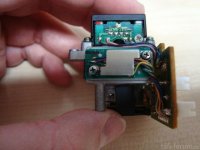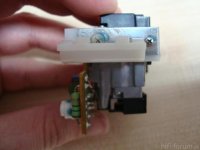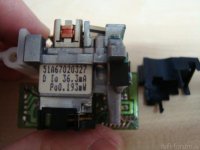I do not know what is the best CD-drive mechanism (yet) but i know (i think i know haha) what is the best CD Transport (incl. cd drive)
The VRDS of Teac is for me the best CD drive mechanism (not technically but audible) but the best transport is the Chord Blu even though it has a lesser CD drive mechanism (i also use a BOW Z88 as transport to compare using the same CD transport used in the Chord Blu) The BOW Z88 can not compete in any way against my TEAC P-10 Transport even though it has the "great" Philips CD-Pro mechanism).
No other CD Transport (maybe the DCS or Esoteric using the latest VRDS mechanisms) can keep up with these units (I have a all CD transports made by Philips in house for comparison incl. the "0", "1" and "9" etc.)
So even if the mechanism is more sturdy and last longer it does not mean it sounds better.
I friend of mine claimed to have one of the best Sony transports but is now looking for an other as the Sony was no match (that is an understatement, he could not listen to his player anymore after this comparison).
So please first try and listen !! to some real good transports (DCS, Chord etc.)
Then the next question arrises:
Why is the Chord better with a lesser transport?
Maybe the electronics that handle the digital stream. If so then we can just forget all about the transport and concentrate on the digital processing.
I would like to try the VRDS on my Chord (so replacing the Pro mechanism with the VRDS one) i just wait until it breaks as it works fine now....so one day i will know...
The VRDS of Teac is for me the best CD drive mechanism (not technically but audible) but the best transport is the Chord Blu even though it has a lesser CD drive mechanism (i also use a BOW Z88 as transport to compare using the same CD transport used in the Chord Blu) The BOW Z88 can not compete in any way against my TEAC P-10 Transport even though it has the "great" Philips CD-Pro mechanism).
No other CD Transport (maybe the DCS or Esoteric using the latest VRDS mechanisms) can keep up with these units (I have a all CD transports made by Philips in house for comparison incl. the "0", "1" and "9" etc.)
So even if the mechanism is more sturdy and last longer it does not mean it sounds better.
I friend of mine claimed to have one of the best Sony transports but is now looking for an other as the Sony was no match (that is an understatement, he could not listen to his player anymore after this comparison).
So please first try and listen !! to some real good transports (DCS, Chord etc.)
Then the next question arrises:
Why is the Chord better with a lesser transport?
Maybe the electronics that handle the digital stream. If so then we can just forget all about the transport and concentrate on the digital processing.
I would like to try the VRDS on my Chord (so replacing the Pro mechanism with the VRDS one) i just wait until it breaks as it works fine now....so one day i will know...
Well, the mechanism with the fewest errors is the best. All transports can hide errors. The quality of how they hide errors will affect sound quality for sure. Hidden errors does not mean that the result is error free at all!!!!
Stable platter mechanisms guarantee errors. Sorry, but that is a fact proved on the bench. The best transport will have a low mass rotating system for the CD, magnetic clamp, not pressure clamp.
Once you say "sounds best", you're off technical grounds completely and this will affect your perception, given how people's brains work. Build quality will affect that too, and Teac does have a high build quality (even if they did it wrong). I really like pretty things too.
-Chris
Stable platter mechanisms guarantee errors. Sorry, but that is a fact proved on the bench. The best transport will have a low mass rotating system for the CD, magnetic clamp, not pressure clamp.
Once you say "sounds best", you're off technical grounds completely and this will affect your perception, given how people's brains work. Build quality will affect that too, and Teac does have a high build quality (even if they did it wrong). I really like pretty things too.
-Chris
For me the best are:
- The last models of Philips CDM with bascular pickup, like CDM-9/65
- Pioneer, specially Plato Stable models.
If you see my other threads, I repair Sony KSS mechanisms, but for me they are not the bests. I like repair sony KSS pickups, but one thing is to like to repair a thing, and other is that thing were considered the best.
- The last models of Philips CDM with bascular pickup, like CDM-9/65
- Pioneer, specially Plato Stable models.
If you see my other threads, I repair Sony KSS mechanisms, but for me they are not the bests. I like repair sony KSS pickups, but one thing is to like to repair a thing, and other is that thing were considered the best.
If the Laser Unit underHi weissi,
Getting back to the title of the thread, nothing has changed.
The NEC transport used in the Alpage and Nakamichi OMS5/7 is the best transport ever sold to the public - ever. The eye pattern was the clearest, most stable and had the fewest digital errors of anything else on the planet. I still have my OMS-7 CD player.
The reason for this is that the mechanics are completely adjustable le:you could align the laser head exactly to the plane of the CD. Once done, you align the servos which now need to do very little correction.
The radial arm Philips transports (early) did the same approximate thing with their alignment. Not as good or effective, but close enough for rock and roll. Good eye pattern, but not as good as the NEC. Failures were the suspension of the lens and the flex cable. I own some Studer machines.
No other transports later than these attempted to align the head to the plane of the CD. A much less good eye pattern results with far greater noise. Philips moved to using the same cheap motor as everyone else (great! can be serviced now). The Sony mechanisms were serviceable and could produce a better eye pattern than the Philips. Many other cheap mechanisms appeared that wore out quickly. The Sanyo SF-90 heads could produce a nice eye pattern when new. No slide bearing - as real shame. They would wear quickly.
Later mechanisms became very cheap with terrible eye patterns. Don't even begin to talk about quality! They don't sound good. Lots of digital errors that are not correctable, but they can be hidden. So your modern transport normally relies on the DSP to hide their problems.
"Stable platters" add rotating mass and prevent the disc motor from correcting the linear velocity of the track quickly as required. A stable platter always increases errors, but it is a sweet idea for consumers who don't understand how CDs work. It ain't a turntable folks! CEC even made a belt drive CD player! That demonstrates how easy it is to sell crap to consumers. Again, the motor cannot correct errors in linear velocity quickly resulting in digital errors.
A spinning CD doesn't wobble. It can be warped, and if it is, a stable platter does not clamp with enough pressure to flatten it. Those claims are false and relate back to an LP on a turntable with weighted clamp (or a pressure clamp). There, an LP is pliable enough to be flattened, but a CD is stiffer and smaller. It does not bend easily folks.
"stable platters" are a farce, period.
-Chris
<?> ??or?? Nakamichi OMS7 ???(NEC HLPL 030020) - MyAV?????
is in use, I agree. - Go also to
2nd. Generation Laser Units HLPL030020 and OHP-32
But there are also versions, where this laser unit resp. optical pich up in use:
JusTone Lasereinheiten. KSS-123A / KSS123A / KSS-121A / KSS121A SONY. Lasereinheit, Laserpickup, Laserunit, Pickup, Laser, Laserkopf, Laufwerk, Mechanism
This quality standard is from my view worse exact like KSS-272A from several models of Accuphase and SONY "ESPRIT" series so as KSS-190A and other versions from SONY's KSS-Series.
In the meantime I recommend user's, who looks for vintage cd player follow models:
A: Top Loader:
1) Krell MD-1 (the only model from Krell without custom made MCU)
2) Micromega SOLO/DUO/TRIO from first series without CDM9-pro (i. e. with CDM1-CDM4)
B: Loader & Tray:
Linn Karik (Laser-Unit: Hitachi HOP-M3)
Linn Karik Compact Disc Player - which Loader ?
Nakamichi OMS5/OMS7 (only with NEC HLPL030020)
Gerner Electronics, Laser pickups, Flexboards, Beamerlampen, Messgeräte
very cheap in used condition:
Cambridge Audio CD-4/CD-6/Discmagic (Laser-Unit: Sanyo SF-91)
NAD5320 (Laser Unit: TAOHS-JP1)
http://vintage-audio-laser.com/liste_dac/images/optique/taohsjp1.html
also very good are most JVC versions with laser units from the Optima series so as most models equipped with the previous mentioned laser units.
Do not choose when buying a used CD player with the following laser units :
1) all brands/models with SONY laser units from KSS-Series
2) Philips CDM9-pro and CDM12 resp. all VAM series (replacement parts for CDM9-pro motor and new flex connections not available, completly assembly hard to find and very expensive, CDM12/VAM parts as replacement all made in China)
3) Sanyo SF-90/SF-P101 especially the models listed in post #5 under
Yba cd2 delta, classe cdp .3, roksan caspian ... main board
An extrem good mechanism without swingarm is the JVC EXU-901A
JVC "EXU-901a" (KRELL KPS-25sc Phase Tech CT-1 CT1) better than VAM1254, CDpro2LF ?
but unfortunately very rare and all cd player models equipped with this very hard to find and expensive.
If the Laser Unit underHi weissi,
Getting back to the title of the thread, nothing has changed.
The NEC transport used in the Alpage and Nakamichi OMS5/7 is the best transport ever sold to the public - ever. The eye pattern was the clearest, most stable and had the fewest digital errors of anything else on the planet. I still have my OMS-7 CD player.
The reason for this is that the mechanics are completely adjustable le:you could align the laser head exactly to the plane of the CD. Once done, you align the servos which now need to do very little correction.
The radial arm Philips transports (early) did the same approximate thing with their alignment. Not as good or effective, but close enough for rock and roll. Good eye pattern, but not as good as the NEC. Failures were the suspension of the lens and the flex cable. I own some Studer machines.
No other transports later than these attempted to align the head to the plane of the CD. A much less good eye pattern results with far greater noise. Philips moved to using the same cheap motor as everyone else (great! can be serviced now). The Sony mechanisms were serviceable and could produce a better eye pattern than the Philips. Many other cheap mechanisms appeared that wore out quickly. The Sanyo SF-90 heads could produce a nice eye pattern when new. No slide bearing - as real shame. They would wear quickly.
Later mechanisms became very cheap with terrible eye patterns. Don't even begin to talk about quality! They don't sound good. Lots of digital errors that are not correctable, but they can be hidden. So your modern transport normally relies on the DSP to hide their problems.
"Stable platters" add rotating mass and prevent the disc motor from correcting the linear velocity of the track quickly as required. A stable platter always increases errors, but it is a sweet idea for consumers who don't understand how CDs work. It ain't a turntable folks! CEC even made a belt drive CD player! That demonstrates how easy it is to sell crap to consumers. Again, the motor cannot correct errors in linear velocity quickly resulting in digital errors.
A spinning CD doesn't wobble. It can be warped, and if it is, a stable platter does not clamp with enough pressure to flatten it. Those claims are false and relate back to an LP on a turntable with weighted clamp (or a pressure clamp). There, an LP is pliable enough to be flattened, but a CD is stiffer and smaller. It does not bend easily folks.
"stable platters" are a farce, period.
-Chris
<?> ??or?? Nakamichi OMS7 ???(NEC HLPL 030020) - MyAV?????
is in use, I agree. - Go also to
2nd. Generation Laser Units HLPL030020 and OHP-32
But there are also versions, where this laser unit resp. optical pick up in use:
JusTone Lasereinheiten. KSS-123A / KSS123A / KSS-121A / KSS121A SONY. Lasereinheit, Laserpickup, Laserunit, Pickup, Laser, Laserkopf, Laufwerk, Mechanism
This quality standard is from my view worse exact than KSS-272A from several models of Accuphase and SONY "ESPRIT" series so as KSS-190A and other versions from SONY's KSS-Series.
In the meantime I recommend user's, who looks for vintage cd player follow models:
A: Top Loader:
1) Krell MD-1 (the only model from Krell without custom made MCU)
2) Micromega SOLO/DUO/TRIO from first series without CDM9-pro (i. e. with CDM1-CDM4)
B: Loader & Tray:
Linn Karik (Laser-Unit: Hitachi HOP-M3)
Linn Karik Compact Disc Player - which Loader ?
Nakamichi OMS5/OMS7 (only with NEC HLPL030020)
Gerner Electronics, Laser pickups, Flexboards, Beamerlampen, Messgeräte
very cheap in used condition:
Cambridge Audio CD-4/CD-6/Discmagic (Laser-Unit: Sanyo SF-91)
NAD5320 (Laser Unit: TAOHS-JP1)
http://vintage-audio-laser.com/liste_dac/images/optique/taohsjp1.html
also very good are most JVC versions with laser units from the Optima series so as most models equipped with the previous mentioned laser units. In my experience, these laser units are very reliable and (probably for that reason) not hard to find and still available.
Do not choose when buying a used CD player with the following laser units :
1) all brands/models with SONY laser units from KSS-Series
2) Philips CDM9-pro and CDM12 resp. all VAM series (replacement parts for CDM9-pro motor and new flex connections not available, completly assembly hard to find and very expensive, CDM12/VAM parts as replacement all made in China)
3) Sanyo SF-90/SF-P101 especially the models listed in post #5 under
Yba cd2 delta, classe cdp .3, roksan caspian ... main board
so as all belt drive versions like CEC and EINSTEIN
An extrem good mechanism without swingarm is the JVC EXU-901A
JVC "EXU-901a" (KRELL KPS-25sc Phase Tech CT-1 CT1) better than VAM1254, CDpro2LF ?
but unfortunately very rare and all cd player models equipped with this very hard to find and expensive.
Last edited:
How many NAK OMS players have been produced do you think?
And how many do you think are still in working order?
My guess is, not many. So you are so lucky to be a non smoker and keeping it alive.
It can not be stated that all OMS players are a good buy just because 2 units here are performing well.
I can say that indeed many of the first generation Philips transports are still in good condition but i would never recommend one.
And how many do you think are still in working order?
My guess is, not many. So you are so lucky to be a non smoker and keeping it alive.
It can not be stated that all OMS players are a good buy just because 2 units here are performing well.
I can say that indeed many of the first generation Philips transports are still in good condition but i would never recommend one.
Last edited:
While thinking about these fundamental alignment issues I believe we agree that the light beam must be exactly perpendicular to the disc.This will result in the returning light beam falling squarely onto the photo-detector array. Therefore very little correction will be required from the servo system.The reason for this is that the mechanics are completely adjustable le:you could align the laser head exactly to the plane of the CD. Once done, you align the servos which now need to do very little correction.
No other transports later than these attempted to align the head to the plane of the CD. A much less good eye pattern results with far greater noise.
Later mechanisms became very cheap with terrible eye patterns. Don't even begin to talk about quality! They don't sound good. Lots of digital errors that are not correctable, but they can be hidden. So your modern transport normally relies on the DSP to hide their problems.
-Chris
Desired result: A stable “eye pattern” with minimal noise & jitter.
I’ve been experimenting with a Sony DVD optical pickup KHM-310BAA.
This is a good example of a modern (cheap) optical pickup which is functional because elaborate DSP algorithms are able to recover data from a crummy eye pattern.
I have a KHM-310BAA optical pickup which stopped working after dismounting its focus/tracking actuator & upper lens for the purpose of cleaning the lower collimating lens.
I accumulated a tall stack of these mid-2000 era Sony DVD players from “the curb,” from resale stores, and from ebay. None cost more than $25 USD. Several were “free.” From them I obtained several optical pickups which work well. P/N are KHM-240AAA, KHM-270AAA, and KHM-310BAA. I have enough spares that I won’t be unhappy if a few optical pickups get destroyed during my experiments.
I already succeeded at using a KHM-270AAA optical pickup recovered from a “parts donor” machine to restore my Sony DVP-NS999ES into perfect working & sounding condition.
My goal is to get this KHM-310BAA working again by making tiny adjustments to the spring-steel support wires which position the upper lens focus/tracking actuator. It might be out of alignment by <1 degree.
My next experiment is with an Onkyo DX-120 CD player from 1986.
I recently dug it out of my storage unit. Current status:
It powers on.
Tray opens and closes.
The carriage drive is functional.
The machine performs a focus search but fails to detect the presence of a disc.
I haven’t checked the laser for light output yet.
I haven’t checked the spindle motor yet either.
Tray opens and closes.
The carriage drive is functional.
The machine performs a focus search but fails to detect the presence of a disc.
I haven’t checked the laser for light output yet.
I haven’t checked the spindle motor yet either.
What intrigues me about this unit is the TAOHS laser pickup (made by Olympus?) and the use of a Yamaha chipset for servo, decoding, and DAC.
The service manual describes a “skew adjustment screw” and states “adjust it for best eye pattern.”
So I’m thinking this machine allows a precise optical alignment to be made.
The TAOHS optical pickups are the “3 beam” type.
Evidently some are still available from NOS.
There are many different suffix numbers for TAOHS pickups. I don’t yet have a feel for interchangeability amongst different TAOHS suffix numbers.
I’d like to get this Onkyo DX-120 into a condition where it will play a disc.
-EB
Onkyo's DX1200 and DX120 uses a laser unit without typing - go to
CD-Player-DAC-Transport List
this forum mentioned only the number "241070" - go to
Unbekannte Lasereinheit, Hifi-Klassiker - HIFI-FORUM
and
Gerner Electronics, Lasereinheiten Laufwerke, Displays, Touchpanels, Folienleiterbahnen u. Reparaturservice
and the images from attachment.
Looks similar to TAOHS-JP1 from Olympus - go to
Changing TAOHS-JP3 vs TAOHS-KP1
CD-Player-DAC-Transport List
this forum mentioned only the number "241070" - go to
Unbekannte Lasereinheit, Hifi-Klassiker - HIFI-FORUM
and
Gerner Electronics, Lasereinheiten Laufwerke, Displays, Touchpanels, Folienleiterbahnen u. Reparaturservice
and the images from attachment.
Looks similar to TAOHS-JP1 from Olympus - go to
Changing TAOHS-JP3 vs TAOHS-KP1
Attachments
tiefbassuebertr, thanks for that info! Your photos show precisely the same optical pickup which is in my Onkyo DX-120.Onkyo's DX1200 and DX120 uses a laser unit without typing - go to
In regards to TAOHS-style optical pickups, there appear to be several different mechanical designs for how the pickup interfaces with the guide rails.
the TAOHS-DG2 in the Onkyo DX-120 has a white nylon plastic slider which is attached with two screws. I assume there is sufficient clearance for the mechanical alignment to be adjusted precisely before the screws are tightened. I've been careful not to disturb the nylon slider position. Its existing mechanical alignment appears to be correct in my Onkyo DX-120.
Other versions of TAOHS pickups have sintered bronze slider bushings which are permanently press-fit into the aluminum case casting.
When I searched the CD player DAC transport list I discovered numerous Yamaha CD player models which contain TAOHS pickups. Carver, NAD, and Kenwood also used them.
FYI, I have a thread for my Onkyo DX-120 CD player restoration project:
Onkyo DX-120 CD player restoration
-EB
Earlier in this thread Anatech wrote about the NEC optical transport used in the Nakamichi OMS-5 and OMS-7:
I just realized the mechanical alignment of the TAOHS optical pickup in my Onkyo DX-120 CD player is also fully adjustable.
This optical pickup has a nylon slider block attached to the left hand side of the optical pickup. I haven’t disturbed it’s alignment (yet). I do suspect it might have been knocked out of alignment previously.
In more detail, this nylon slider assembly is attached to a vertical surface on the left hand side of the optical pickup with 2 machine screws. One of these screws has a very large diameter head. I suspect the hole in the nylon slider (underneath the screw head) is large enough to permit vertical adjustment when this screw is loosened. These screws appear to have been untouched since their initial factory adjustment. They are secured with transparent green-tinted glue. Making an adjustment at the location of the screw with the large head will tilt the optical pickup in the radial plane (from center of disc to edge of disc).
This machine also has an easily adjustable “skew” alignment cam which raises/lowers the right hand side of the optical pickup. Therefore this tilts the optical pickup in the tangential plane (parallel to the track on the disc). The service manual states: “adjust skew for best eye pattern.” Unfortunately the best adjustment for my machine is all the way at one extreme. Not in the middle of the adjustment cam’s range. On this side of the optical pickup (right hand side) there is a horizontal sheet metal plate attached to the optical pickup with two screws (non adjustable). The plastic skew adjustment cam is inserted into this horizontal plate. I think a “coarse” adjustment could be accomplished here with shims in order to end up with the skew adjustment cam fairly close to being centered when the best eye pattern is achieved.
I’ll post the results of my mechanical alignment in my thread about the Onkyo DX-120.
-EB
The reason for this is that the mechanics are completely adjustable le:you could align the laser head exactly to the plane of the CD. Once done, you align the servos which now need to do very little correction.
I just realized the mechanical alignment of the TAOHS optical pickup in my Onkyo DX-120 CD player is also fully adjustable.
This optical pickup has a nylon slider block attached to the left hand side of the optical pickup. I haven’t disturbed it’s alignment (yet). I do suspect it might have been knocked out of alignment previously.
In more detail, this nylon slider assembly is attached to a vertical surface on the left hand side of the optical pickup with 2 machine screws. One of these screws has a very large diameter head. I suspect the hole in the nylon slider (underneath the screw head) is large enough to permit vertical adjustment when this screw is loosened. These screws appear to have been untouched since their initial factory adjustment. They are secured with transparent green-tinted glue. Making an adjustment at the location of the screw with the large head will tilt the optical pickup in the radial plane (from center of disc to edge of disc).
This machine also has an easily adjustable “skew” alignment cam which raises/lowers the right hand side of the optical pickup. Therefore this tilts the optical pickup in the tangential plane (parallel to the track on the disc). The service manual states: “adjust skew for best eye pattern.” Unfortunately the best adjustment for my machine is all the way at one extreme. Not in the middle of the adjustment cam’s range. On this side of the optical pickup (right hand side) there is a horizontal sheet metal plate attached to the optical pickup with two screws (non adjustable). The plastic skew adjustment cam is inserted into this horizontal plate. I think a “coarse” adjustment could be accomplished here with shims in order to end up with the skew adjustment cam fairly close to being centered when the best eye pattern is achieved.
I’ll post the results of my mechanical alignment in my thread about the Onkyo DX-120.
-EB
Hi EB,
The Nakamichi transport is completely adjustable in free space in every plane. What you have is an azimuth adjustment. This is very good!
By all means, shim it to get in a better adjustment range. But, this appears to indicate that something is out of alignment. Look for cracked nylon or something bent. In my experience, this should be relatively centered in the adjustment range. However, as long as you can bring it into alignment you should be okay.
-Chris
The Nakamichi transport is completely adjustable in free space in every plane. What you have is an azimuth adjustment. This is very good!
By all means, shim it to get in a better adjustment range. But, this appears to indicate that something is out of alignment. Look for cracked nylon or something bent. In my experience, this should be relatively centered in the adjustment range. However, as long as you can bring it into alignment you should be okay.
-Chris
I have a Phase Linear 9500 CD player which may contain an optical pickup similar to the Nakamichi OMS-5/7.
According to the CD-player-DAC-Transport list:
PHASE LINEAR 9500 | 2xTDA1540D–SAA7030 | HLPL 030010 (Toshiba OPH-31)
NAKAMICHI OMS-7 | 2xTDA1540D–SAA7030 | HLPL 030020 (CA80255A)
I think I have the service manual for the Phase Linear 9500 too.
-EB
According to the CD-player-DAC-Transport list:
PHASE LINEAR 9500 | 2xTDA1540D–SAA7030 | HLPL 030010 (Toshiba OPH-31)
NAKAMICHI OMS-7 | 2xTDA1540D–SAA7030 | HLPL 030020 (CA80255A)
I think I have the service manual for the Phase Linear 9500 too.
-EB
Hi EB,
It would be interesting to have a look and compare.
Looking at a low res copy of the service manual, that appears to be a radial arm setup if the terminology in the manual is to be believed. A picture of the underside of the transport would tell the tail for sure.
The head is a single beam system for sure.
-Chris
It would be interesting to have a look and compare.
Looking at a low res copy of the service manual, that appears to be a radial arm setup if the terminology in the manual is to be believed. A picture of the underside of the transport would tell the tail for sure.
The head is a single beam system for sure.
-Chris
I discovered that I have not one but two of these Phase Linear 9500 CD players. I haven't inspected either one of them closely yet but they are moving closer to my workbench.I have a Phase Linear 9500 CD player which may contain an optical pickup similar to the Nakamichi OMS-5/7.
From CD-player-DAC-Transport list:
PHASE LINEAR 9500 | 2xTDA1540D–SAA7030 | HLPL 030010 (Toshiba OPH-31)
NAKAMICHI OMS-7 | 2xTDA1540D–SAA7030 | HLPL 030020 (CA80255A)
-EB
Hello @tiefbassuebertr and thank you for the contributions. I had read elsewhere that Philips CDM3 was "troublesome" and as with many other mechs, parts are not available. Is there new data or a new development in repair method that places CDM3 as being as reliable as CDM1 or CDM4? Thank you!
Hello @anatech it seems you have a lot of experience with the Nakamichi OMS 5 and 7 which is very cool! I would like to buy one but I do see see a few "parts" units for sale which indicates to me they do occasionally have issues. One seller reported replacing a "sled belt" and all was good. I am worried that there are only a few people, you being one of them, who could properly set up one of these lasers should something else go wrong.
More to the point, do you consider the HLPL 030020 / CA80255A as "most reliable" or rather "best engineered" if maybe they are not the same thing? Thank you!
More to the point, do you consider the HLPL 030020 / CA80255A as "most reliable" or rather "best engineered" if maybe they are not the same thing? Thank you!
It is the same laser as used in CEC TL0 !!!!CD drive mechanism that really impressed me recently is the one pictured below. It can be bought for $15, yet implemented in a CDP it rivals CEC TL0 and ML31.5 (in certain ways).
- Home
- Source & Line
- Digital Source
- Best CD drive mechanism
